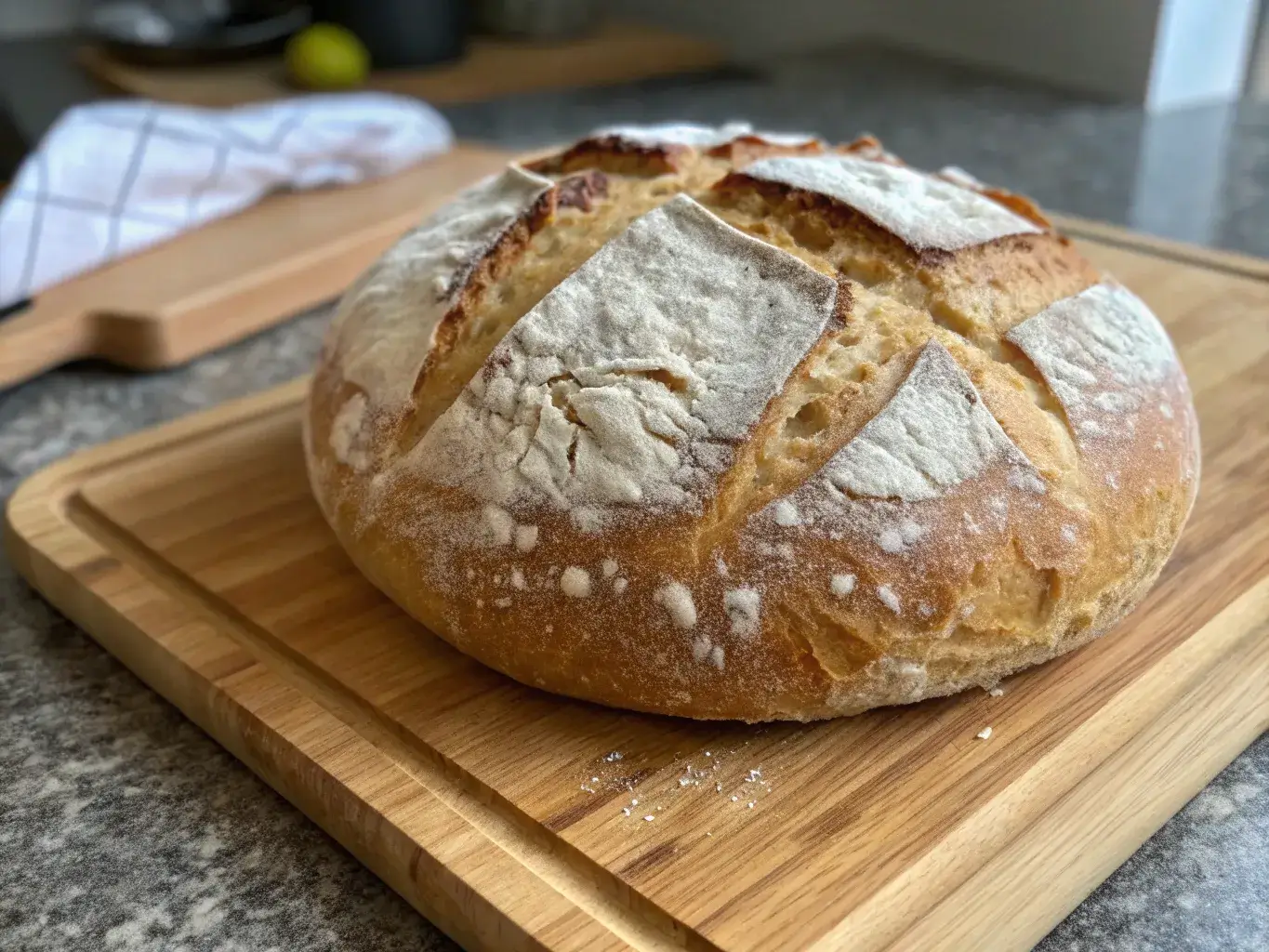Bolted flour in sourdough bread is the perfect balance between whole grain nutrition and a soft, airy loaf. This partially sifted flour helps create bread with a light crumb, crisp crust, and rich flavor.
In this guide, you’ll learn what bolted flour is, why it works so well in sourdough, and how to use it for the best results.
Understanding Bolted Flour in Sourdough Bread
What Is Bolted Bread Flour?
When bakers talk about bolted flour in sourdough bread, they’re referring to flour that has been partially sifted after milling. This process removes some of the bran while leaving much of the wheat germ and endosperm intact. The result is a flour that produces loaves lighter than whole wheat but more flavorful and nutritious than refined white flour.
Unlike fully refined flour, bolted flour still has a creamy color and a slightly earthy flavor. For those new to baking sourdough, it offers a middle ground that makes handling dough easier while still delivering the deep character fresh milled flour is known for.
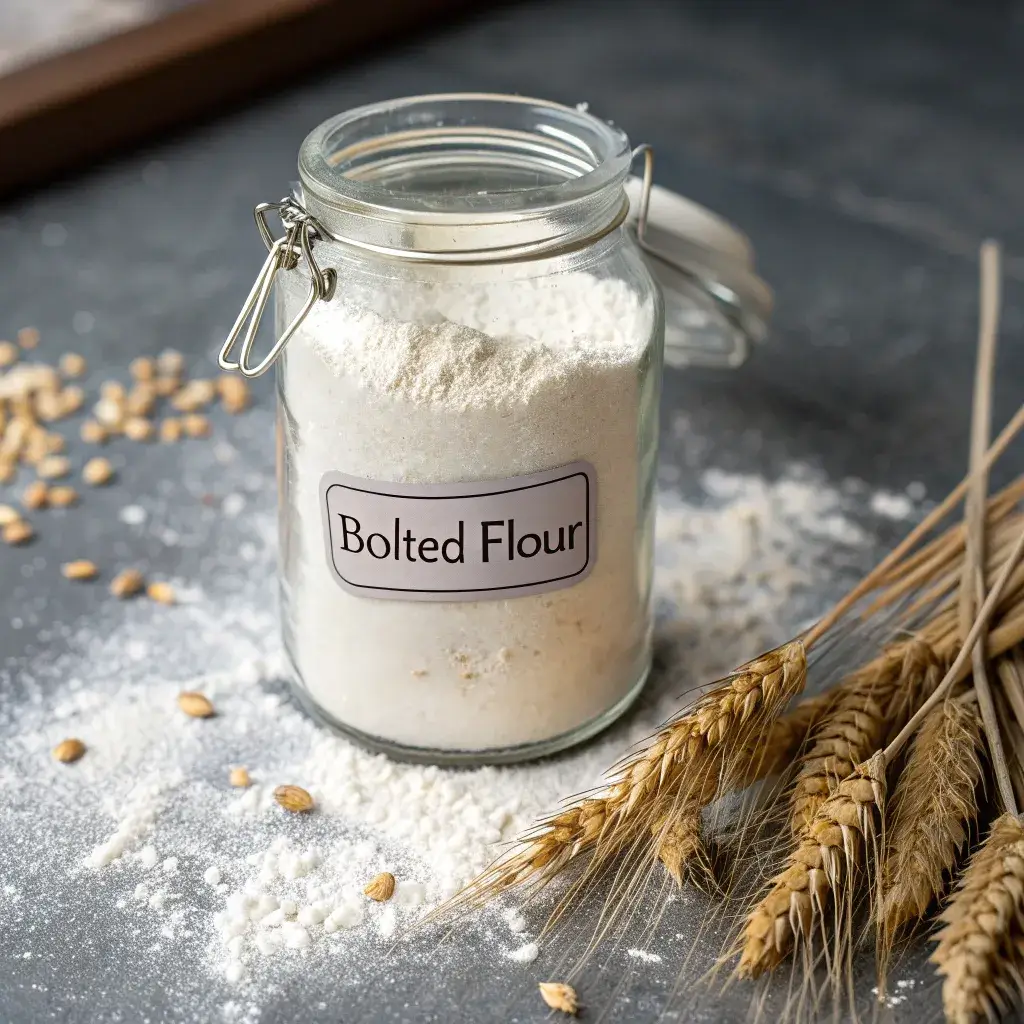
The Difference Between Bolted and Unbolted Flour
The main difference between bolted flour in sourdough bread and unbolted flour is the sifting.
- Unbolted flour includes 100% of the grain—bran, germ, and endosperm—creating dense, hearty loaves.
- Bolted flour has some bran removed, which allows for better fermentation, easier gluten development, and more oven spring.
| Flour Type | Texture of Bread | Flavor Profile | Fermentation Speed | Crust & Crumb |
|---|---|---|---|---|
| Unbolted (Whole) | Dense, hearty | Earthy, nutty flavor | Slower | Thick crust |
| Bolted (High Extraction) | Light yet hearty | Balanced, mildly sweet | Faster | Crispy crust, soft crumb |
| White (Refined) | Very light | Mild, less complex | Fastest | Thin crust |
Nutritional Profile of Bolted Flour in Sourdough Bread
Even with some bran removed, bolted flour delivers strong nutritional benefits compared to refined flour. A typical loaf of bolted flour in sourdough bread provides:
- Fiber for healthy digestion
- B vitamins like thiamine and niacin
- Rich in iron and magnesium, they help support energy levels and muscle health.
- A balanced protein c ontent that strengthens gluten networks
This makes it ideal for bakers who want a loaf that’s both nutritious and enjoyable to eat.
Print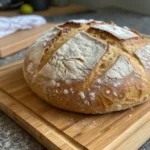
Bolted Flour in Sourdough Bread: A Complete Beginner’s Guide
- Total Time: 12 hours 45 minutes
- Yield: 1 loaf 1x
- Diet: Vegan
Description
A rustic sourdough bread made with bolted flour, offering a balance between whole grain nutrition and a lighter, more open crumb.
Ingredients
500g bolted flour (high-extraction wheat flour)
350g water (room temperature)
100g active sourdough starter (100% hydration)
10g salt
Instructions
1. In a large bowl, mix the bolted flour and water until no dry bits remain. Cover and let rest for 30 minutes (autolyse).
2. Add the sourdough starter and mix well, then add salt and incorporate fully.
3. Perform 3–4 sets of stretch and folds every 30 minutes during the first 2 hours of bulk fermentation.
4. Let the dough bulk ferment at room temperature (about 75°F/24°C) for 4–5 hours, or until it has risen 50% and feels airy.
5. Turn dough onto a lightly floured surface and pre-shape into a round. Rest for 20 minutes.
6. Shape into a boule or batard and place in a floured proofing basket.
7. Cover and refrigerate overnight (8–12 hours).
8. Preheat oven to 475°F (245°C) with a Dutch oven inside.
9. Carefully transfer dough to parchment paper, score the top, and place into the hot Dutch oven.
10. Bake covered for 20 minutes, then uncover and bake another 20–25 minutes until deep golden brown.
11. Cool on a wire rack for at least 1 hour before slicing.
Notes
Bolted flour retains some bran and germ for flavor and nutrition while still producing a lighter loaf than whole wheat.
Hydration may need adjusting depending on the flour’s absorption—add more water if dough feels stiff.
For extra flavor, extend the cold proofing time up to 16 hours.
Best enjoyed with butter, cheese, or as a base for hearty sandwiches.
- Prep Time: 12 hours
- Cook Time: 45 minutes
- Category: Bread
- Method: Baking
- Cuisine: Rustic
Nutrition
- Serving Size: 1 slice
- Calories: 160
- Sugar: 0g
- Sodium: 200mg
- Fat: 1g
- Saturated Fat: 0g
- Unsaturated Fat: 0g
- Trans Fat: 0g
- Carbohydrates: 34g
- Fiber: 3g
- Protein: 5g
- Cholesterol: 0mg
Keywords: sourdough bread, bolted flour, artisan bread, high extraction wheat
Why Use Bolted Flour in Sourdough Bread
Benefits for Texture and Flavor
One of the biggest reasons bakers choose bolted flour in sourdough bread is the balance it strikes between lightness and nutrition. Bolted flour produces a crumb that’s soft and airy, yet still carries the earthy depth of whole grains. This means you can enjoy a rustic loaf without the overly dense texture that often comes with 100% whole wheat.
The flavor is another highlight. Bolted flour tends to produce bread with a subtle sweetness and nutty undertone, making it an excellent match for both sweet toppings like honey and savory pairings such as cheese or soups.
Impact on Fermentation, Hydration, and Crumb
Because bolted flour contains less bran than whole wheat, it allows gluten to form more easily. This not only gives better structure but also speeds up fermentation. Many bakers notice that their doughs bulk ferment quicker with bolted flour compared to unbolted whole wheat.
Hydration plays a big role here. For example, a 75% hydration dough often yields the best balance when using fresh milled flour. Higher hydration can create a more open crumb, but it also risks flatter loaves if the gluten network isn’t strong enough. Bolted flour helps reduce that risk, allowing bakers to experiment with slightly higher hydration without losing oven spring.
When proofing, bolted flour tends to show signs of readiness earlier. Bakers in cooler kitchens may need to extend bulk fermentation by 30–60 minutes, while those in warmer homes might shorten the process. Keeping a dough journal with hydration levels and room temperatures is an excellent way to perfect timing.
Comparing Bolted Flour vs. Whole Wheat in Sourdough
If you’ve struggled with dense or heavy loaves, switching from whole wheat to bolted flour in sourdough bread may be the game changer you need. Here’s a simple breakdown:
| Feature | Whole Wheat Flour | Bolted Flour |
|---|---|---|
| Gluten Development | More challenging | Easier |
| Fermentation Speed | Slower | Faster |
| Hydration Tolerance | Lower (70–72%) | Higher (75%+) |
| Texture of Loaf | Dense | Lighter |
| Flavor Complexity | Strong, nutty | Balanced, sweet-nutty |
By adjusting hydration and carefully watching fermentation, bolted flour allows you to bake loaves that rise beautifully, slice cleanly, and still deliver the nutrition of fresh milled grains.
How to Calculate Hydration for Bolted Flour in Sourdough Bread
Hydration refers to the ratio of water to flour in your dough, and it plays a huge role in the final texture of your loaf. With bolted flour in sourdough bread, bakers often find that around 75% hydration yields a soft, moist crumb without the loaf collapsing.
The formula is:
(Weight of Water ÷ Weight of Flour) × 100 = Hydration %
Here’s an example using fresh milled and bolted flour:
| Ingredient | Weight (grams) | Notes |
|---|---|---|
| Bolted Flour | 600g | From fresh milled wheat |
| Water | 438g | Room temperature |
| Sourdough Starter (100%) | 102g | 51g water + 51g flour |
| Salt | 15g | Flavor and gluten control |
Total Hydration Calculation:
- Total water = 438g + 51g = 489g
- Total flour = 600g + 51g = 651g
- Hydration = (489 ÷ 651) × 100 ≈ 75%
This hydration level works especially well for bolted flour, balancing oven spring with a pleasant crumb. If you want a more open crumb, experiment with slightly higher hydration, but be aware that too much water can flatten your loaf.
How to Choose the Right Bolted Flour in Sourdough Bread
Types of Bolted Flour for Sourdough Baking
When selecting flour for bolted flour in sourdough bread, not all options are equal. The most common types are:
- Hard Red Wheat (bolted) offers a strong gluten structure and a rich, nutty flavor.
- Hard White Wheat (Bolted) produces a lighter loaf with a milder flavor.
- Stone-Milled High Extraction Flour retains more nutrients and a rustic character while still being easier to handle than full whole wheat.
Some bakers prefer mixing 50% hard red with 50% hard white for the best balance between strength and flavor.
Factors to Consider When Buying
When buying bolted flour, look for these qualities:
- Protein Content: Aim for 11–13% protein to ensure a good gluten network.
- Freshness: Freshly milled and bolted flour retains more nutrients and flavor.
- Extraction Rate: The percentage of flour that remains after sifting. Higher extraction means closer to whole grain; lower extraction produces a lighter loaf.
- Source & Milling Method: Stone-milled flour usually maintains better flavor and nutrients than roller-milled flour.
Best Storage Practices for Freshness
To preserve the quality of bolted flour in sourdough bread, store it properly:
- Keep in an airtight container away from light and moisture.
- Use within 3–4 weeks if kept at room temperature.
- For longer storage, refrigerate or freeze in sealed bags to retain freshness.
Tip: Always let cold flour come back to room temperature before mixing your dough to avoid slowing fermentation.
Understanding Extraction Rates in Bolted Flour
The extraction rate is the percentage of the whole grain that remains in the flour after sifting. For bakers working with bolted flour in sourdough bread, knowing this percentage is key to predicting dough behavior.
| Flour Type | Extraction Rate | Texture & Color | Nutritional Value | Best For |
|---|---|---|---|---|
| White Flour (Refined) | 70–75% | Very light, pale crumb | Lowest fiber & minerals | Very light sourdough |
| Bolted Flour (High Extraction) | 80–90% | Off-white, creamy crumb | High in nutrients, moderate fiber | Balanced sourdough loaves |
| Whole Wheat (Unbolted) | 95–100% | Dark, hearty crumb | Maximum fiber & nutrients | Dense, rustic sourdough |
Most artisan bakers prefer 80–90% extraction bolted flour because it balances oven spring with nutrition. A higher extraction (closer to 90%) yields more flavor and nutrients but requires careful hydration management. Lower extraction (closer to 80%) produces lighter, easier-to-handle doughs.
Tip: If you’re transitioning from store-bought flour, start with bolted flour around 85% extraction for the smoothest adjustment.
Buyer’s Checklist for Bolted Flour
When choosing the right flour for bolted flour in sourdough bread, keep this quick checklist in mind:
- Check Protein Content: Aim for 11–13% for good gluten development.
- Look at Extraction Rate: 80–90% extraction is best for balanced sourdough.
- Choose Freshly Milled: Fresher flour means better fermentation and flavor.
- Prefer Stone-Milled: Retains more nutrients and aroma than roller-milled.
- Inspect Packaging: Airtight, moisture-proof bags protect flour quality.
- Source Locally If Possible: Shorter supply chains mean fresher flour.
- Buy in Small Batches: Prevents staleness and ensures flour stays lively.
Using this checklist ensures that your bolted flour supports both flavor and structure in your sourdough.
Using Bolted Flour in Your Sourdough Starter
Can I Feed My Sourdough Fresh Milled Flour?
Yes, you can feed your sourdough starter with fresh milled flour. Many bakers find that starters fed with bolted flour in sourdough bread ferment faster and stay more active. The reduced bran content makes the starter less acidic while still providing the natural yeast and bacteria with the nutrients they need.
Tip: Transition your starter gradually by mixing bolted flour with your usual flour for a few days. This helps the culture adjust smoothly without shock.
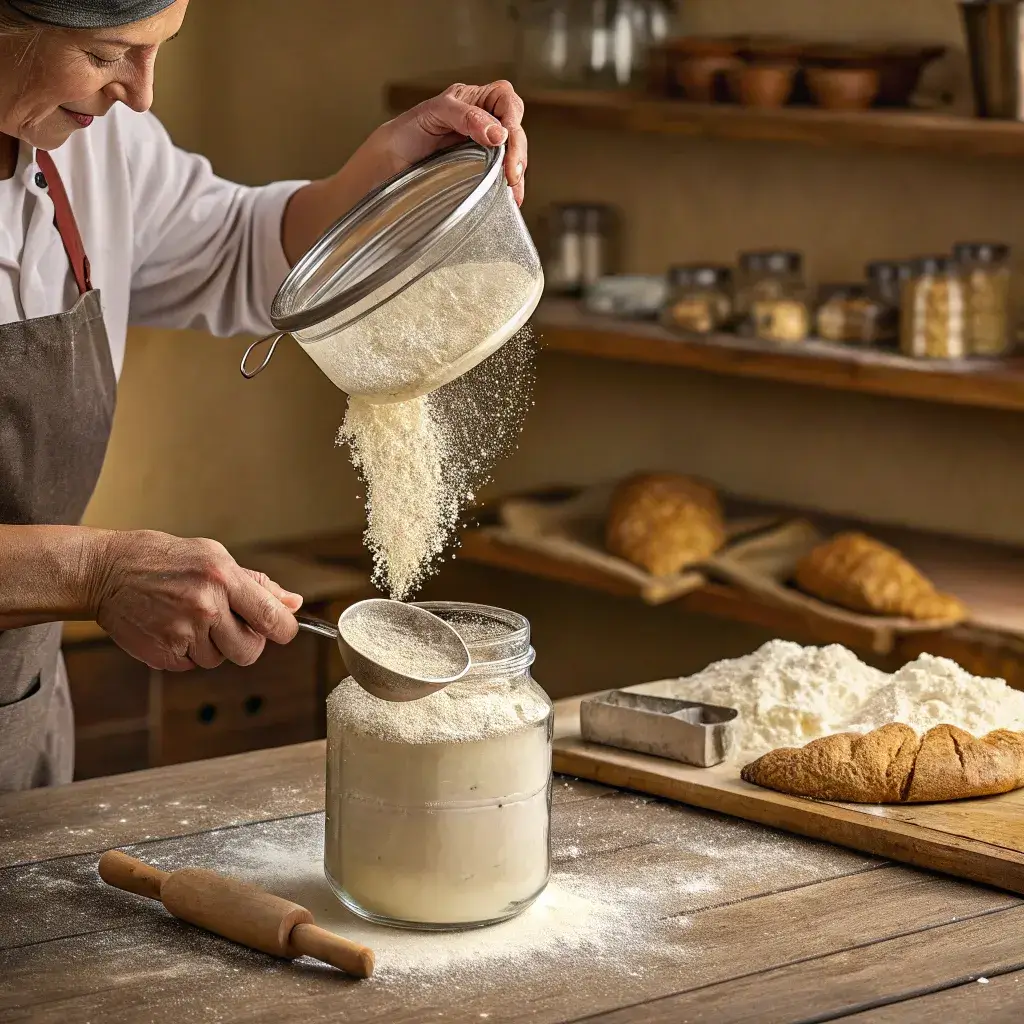
Transitioning from White to Bolted Flour in a Starter
Switching a sourdough starter from white flour to bolted flour in sourdough bread is simple, but patience is key. Expect the texture and fermentation speed to change:
- Day 1–3: Use 50% white flour, 50% bolted flour.
- Day 4–6: Move to 75% bolted flour, 25% white flour.
- Day 7+: Feed with 100% bolted flour.
During this process, watch for changes in rise and bubbles. If your starter appears sluggish, extend feeding times slightly.
Troubleshooting Starter Issues with Bolted Flour
- Problem: Starter too acidic.
Solution: Reduce fermentation time or feed more often. - Problem: Weak rise.
Solution: Add a spoon of whole grain flour to boost activity. - Problem: Starter too thin.
Solution: Lower hydration slightly until strength returns.
Mixing and Hydration Tips
How Bolted Flour Affects Dough Hydration
When baking with bolted flour in sourdough bread, hydration management is crucial. Because bolted flour absorbs water differently than white flour, it usually requires slightly higher hydration to keep dough supple. Many bakers find 75% hydration a sweet spot.
Bolted flour also creates dough that feels tighter during the first mix but relaxes during bulk fermentation. Don’t panic if your dough looks dry at first — the flour will absorb the water over time.
Adjusting Water Ratios for Best Results
Here’s a hydration example for a 600g flour recipe:
| Ingredient | Weight | Notes |
|---|---|---|
| Bolted Flour | 600g | High extraction |
| Water | 438g | Room temp |
| Starter (100%) | 102g | Adds 51g flour + 51g water |
| Salt | 15g | Flavor control |
Hydration = 489g water ÷ 651g flour = 75%
For beginners, stick to 70–75%. If you want a more open crumb, experiment with 78–80%, but keep in mind that higher hydration may reduce oven spring.
What Happens If You Put Too Much Flour in Your Sourdough?
Adding too much flour when mixing or shaping can throw off hydration balance. With bolted flour in sourdough bread, this often leads to:
- Dense, heavy loaves with little oven spring
- A tight, dry crumb
- Underdeveloped gluten
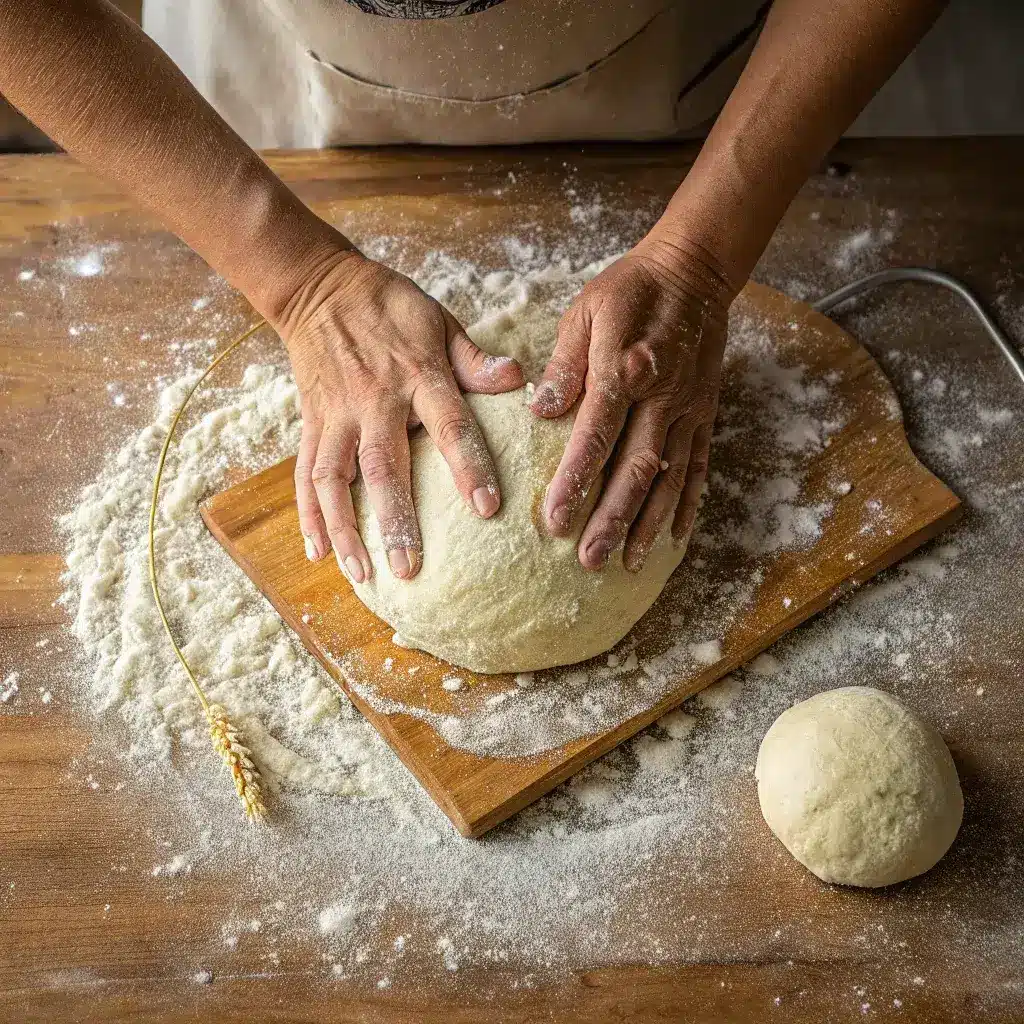
To avoid this, flour your work surface lightly and use rice flour for dusting bannetons — it prevents sticking without altering hydration
Managing Proofing with Bolted Flour in Sourdough Bread
How Bolted Flour Affects Proofing Times
Because of its partially sifted nature, bolted flour in sourdough bread tends to ferment and proof faster than whole wheat but slower than pure white flour. This means you’ll need to pay close attention to dough cues instead of just the clock.
Typical bulk fermentation with bolted flour ranges from 4–6 hours at 70–75°F, depending on hydration and starter activity. Cooler kitchens may require 30–60 minutes more, while warmer rooms may shorten proofing time.
Can I Add Flour to Overproofed Sourdough?
If your dough overproofs, adding more flour won’t fix the problem. Instead, use it creatively:
- Shape it into a focaccia or flatbread
- Bake it as a rustic loaf with less scoring
- Repurpose into garlic bread or croutons
Adding flour after proofing disrupts gluten and usually makes the bread denser. It’s better to learn to read signs of readiness, such as dough volume increase and the “finger poke test.”
Signs Your Dough Is Properly Proofed
With bolted flour in sourdough bread, watch for these proofing indicators:
- Dough has nearly doubled in size
- A gentle poke springs back slowly, leaving a slight dent
- Surface feels airy yet elastic
- Small bubbles are visible along the edges
Catching the dough at this stage helps ensure excellent oven spring and a well-balanced crumb.
Baking Techniques for Bolted Flour in Sourdough Bread
Scoring and Oven Spring Tips
When baking with bolted flour in sourdough bread, scoring is essential to control oven spring. Because bolted flour ferments faster than whole wheat, your dough may rise quickly in the oven. A main score of ¼–½ inch deep allows gases to escape evenly, preventing uncontrolled cracks. Decorative scoring is optional but should be shallower (around ¼ inch).
Tip: Chill the dough in the fridge before scoring. Cold dough slashes more cleanly, which is especially helpful when using bolted flour.
Temperature Adjustments for Bolted Flour
Bolted flour tends to brown faster due to its higher mineral content. Bake your loaf at 450°F (232°C) for the first 20 minutes with steam, then reduce to 425°F (218°C) until fully baked. This method helps maintain a crisp crust without burning.
Achieving the Perfect Crust and Crumb
With bolted flour, your crumb will likely be more closed than that of a white sourdough but more open than whole wheat. Aim for 75–78% hydration for a balance of oven spring and softness. To keep the crust crisp, let your loaf cool completely on a wire rack before slicing.
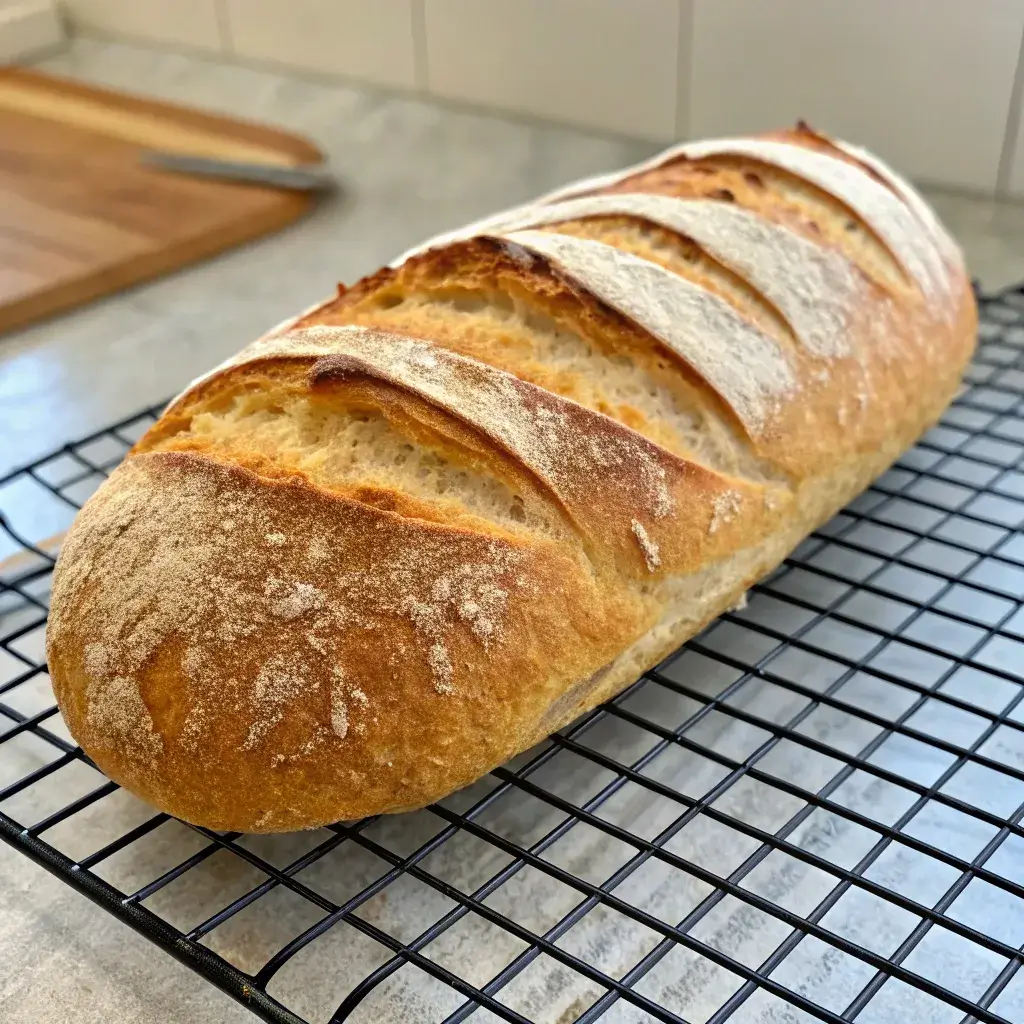
Common Mistakes and How to Avoid Them
Overflouring and Dense Loaves
One common issue when using bolted flour in sourdough bread is over-flouring during shaping. Too much bench flour lowers hydration and leads to heavy, dry loaves. Instead, dust lightly with rice flour to prevent sticking without altering the recipe balance.
Underproofing vs. Overproofing with Bolted Flour
- Underproofing often causes “blowouts” where dough cracks outside of the scoring.
- Overproofing results in flat, spread-out loaves with little oven spring.
Bolted flour ferments faster, so use the “finger poke test” and keep a dough journal to track times.
Storage Mistakes That Affect Flavor
To keep your bread fresh:
- Store cooled loaves in a paper bag inside a bread box for up to 3 days.
- For longer storage, wrap tightly in foil or plastic and freeze for up to 3 months.
- Avoid airtight plastic at room temperature it softens the crust.
FAQ About Bolted Flour in Sourdough Bread
What Is Bolted Bread Flour?
Bolted flour is partially sifted fresh milled flour that keeps most of the flavor and nutrients of whole wheat while producing lighter sourdough loaves.
What Happens if You Put Too Much Flour in Your Sourdough?
Adding too much flour, especially when working with bolted flour in sourdough bread, can lower hydration and result in dense loaves with poor oven spring. Always measure carefully and avoid heavy dusting during the shaping process.
Can I Feed My Sourdough Fresh Milled Flour?
Yes. Starters thrive on fresh milled and bolted flour. Just introduce the new flour gradually so your culture adapts smoothly.
Can I Add Flour to Overproofed Sourdough?
No. Adding flour after proofing won’t fix overproofing. Instead, repurpose the dough as focaccia, flatbread, or croutons.
Mastering Bolted Flour in Sourdough Baking
Working with bolted flour in sourdough bread allows you to enjoy loaves that are both nutritious and delicious. With the right hydration, careful proofing, and mindful baking techniques, you can achieve bread that has a crisp crust, a tender crumb, and a flavor that celebrates the best of freshly milled grains. Whether you’re just beginning your sourdough journey or fine-tuning your craft, bolted flour offers the balance you’ve been looking for.

